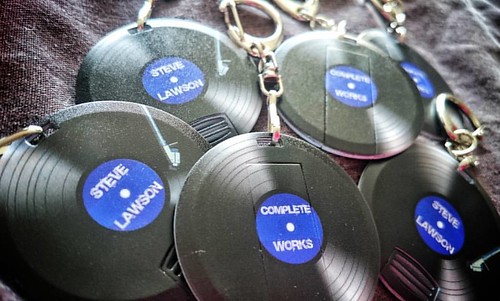 I’ve finally started work on mixing the rest of the recordings from the FingerPainting project. The existing recordings are from 2012-2013, all ten shows available as a download, a complete document of everything that Daniel Berkman, Artemis and I had played together up until that point. But we did another tour in 2014, and until this week, they’d remained untouched in my Reaper-recordings-vault. Too massive a venture to contemplate, especially after the absolutely mammoth task of mixing and mastering the first lot, which put a huge strain on the rest of my life for about four months in 2013. However, this week I decided to see what would happen if I mixed and mastered them really quickly – applied a much lighter touch than I did to the processing last time round – FingerPainting was right at the beginning of my journey with professional-quality mastering work, and the project taught me SO much. But it also took an extraordinary amount of time, as I worked on getting the perfect sound for every aspect. Continue reading “Crossing The River – When Albums Move From Product To Chapter”
I’ve finally started work on mixing the rest of the recordings from the FingerPainting project. The existing recordings are from 2012-2013, all ten shows available as a download, a complete document of everything that Daniel Berkman, Artemis and I had played together up until that point. But we did another tour in 2014, and until this week, they’d remained untouched in my Reaper-recordings-vault. Too massive a venture to contemplate, especially after the absolutely mammoth task of mixing and mastering the first lot, which put a huge strain on the rest of my life for about four months in 2013. However, this week I decided to see what would happen if I mixed and mastered them really quickly – applied a much lighter touch than I did to the processing last time round – FingerPainting was right at the beginning of my journey with professional-quality mastering work, and the project taught me SO much. But it also took an extraordinary amount of time, as I worked on getting the perfect sound for every aspect. Continue reading “Crossing The River – When Albums Move From Product To Chapter”
New Live Album With Corey Mwamba Out Now
I just released a new album! Surprise is a duo live recording with vibraphonist Corey Mwamba, from a show in London. It’s all improvised, and provides a beautiful stopping off point in my musical journey with Corey thus far.
We first played together over a decade ago, brought together by Orphy Robinson for a trio gig in Derby. There was an instant musical chemistry, and the next stage was me playing in Corey’s group Argentum at the London Jazz Festival a couple of years later. Since then we’ve played a handful of shows together – always a rich experience, and always with the intention of doing more.
This latest opportunity came when a friend who was booking a percussion-based show asked if I could do a set with a vibraphonist – the tuned percussion being the hook, the improvised nature of it providing the trust that we’d bring something that would ‘fit’… And we did. There’s something wonderful but also otherworldly about playing improvised music to an audience who have no idea who you are, and about whom you know very little. The music stands apart from the relationship between artist and audience in a way that I’m largely unfamiliar with (the nature of my career means that I’m often playing to audiences with whom I have a much longer musical relationship).
You can hear the album here, and buy it if you like it:
As a result, it took me quite a few listens to the recording to hear what’s in there. I was remembering the experience of not knowing, or hearing and being unable to contextualise. Fortunately, I stuck with the music’s leadings and we came up with this. It is, to my ears, a deeply satisfying album, with many twists and turns across its 25 minutes. Playing with Corey is always a joy. He’s an inspiring human and a truly masterful musician and improvisor. More soon, I hope. x
Note: this album was released to my Bandcamp subscribers last December, four months before it became public. Now that it’s public it’s no longer part of the subscriber back catalogue (though, obviously, all those who got it as part of their subscription own it for ever 🙂 ) – there are a number of other collaborative recordings that have been released to subscribers over the last couple of months that will be coming out publicly soon. When they do, they’ll cease to be part of the Subscriber back catalogue too. So, if you want everything, there’s no better time to subscribe than now. If you want to fill in the blanks, you can of course buy the albums that you’re missing from your collection as individual downloads – the pricing is v. cheap to reflect the otherwise overly expensive task of trying to keep on top of all this amazing new music 😉
Thoughts on Cecil Taylor
Listening to this and thinking about Cecil Taylor. His legacy, his choices, his extraordinarily personal take on music.
He’s someone whose choices inspired me for many decades. When I first heard that he chose to wash dishes rather than capitulate to the way the clubs that would book him wanted him to play, it literally changed the path of my music career. He’s an avatar for choosing the hard road. Choosing a path like that is not a one-off choice that you tell your friends about to make yourself look like some bad-ass. To be as accomplished a musician as Cecil was, and still choose to keep your music as a sacred thing not to be messed with just to pay the bills, is an extraordinary commitment. It’s not like he couldn’t have played standards as well as anyone if he’d wanted to – he even recorded a bunch of standards later in life – but he saw something as bigger than the status of being ‘full time in music’.
I spent a lot of years thinking that being full time was the aim. Cecil’s witness was a huge part of me getting past that point and realising that the music was way too important to make it bland just to get a gig. It’s a position that’s put me at odds with some of the places I’ve worked, and it’s a lesson that I’ve had to relearn a bunch of times, but thinking I could make my music ‘fit’ (and I’ve always been happy to play other people’s music as a ‘job’, and do the occasional function band – it’s just my own creative path that I’ve been more protective of) – but thanks to what I gleaned from Cecil’s path, I’m still doing the thing I do, finding the places where it fits, and refusing to screw it up to fit some booker’s idea of what I ought to be doing. I do WAY fewer gigs than I otherwise might, but Cecil is there to illuminate the long game.
RIP, Cecil – you influenced a huge amount of people, made some extraordinary music, and I’m materially less well-off because of your example, but infinitely happier with my creative choices. Thank you x
What Does It Mean To Do Your Own Thing?
 Light and Shade
Light and Shade
High and Low
Fast And Slow
Loud and Soft
Harsh and Mellow
Tension and Resolution
Inside and Outside
Sound and Silence
…the spread of options can be seen both in a micro and macro senses. It’s OK (caveat – of course, anything’s OK, it’s your creative practice here… but Imma try not to get bogged down in overly-explanatory language) to say ‘actually, my role within the scope of things happening in my field is to explore only shade.’ You don’t have to do everything or be everything. Your art is not a school science project to be graded on a set of learning outcomes.
BUT. As orthodoxies and modes of practice within particular disciplines emerge and coalesce around a limited set of expressive options, the invitation is built into that to transgress, explore, colour outside the lines, stay INSIDE the lines when everyone else is going nuts… Your practice is yours, but it exists within an ecosystem that’s partly of your own choosing and partly in the perception and experience of your audience. You can opt to ignore that and be ‘true to yourself’ or however you want to frame it, but when everyone is ploughing the same furrow, your seemingly radical notions are seen in that light.
An example – when I first started playing solo with a looper, a ton of (obviously inexperienced) people thought I’d invented it. Like I was the first person to ever do that. Even to those who had come across it before as an idea, there were very few who could name another solo artist using a looper, and even fewer who had ever seen someone play like that. It was, in short, a killer gimmick. I used to do this schtick where in the second tune in my set (back when I played compositions with actual names n shit) and go to the bar, leaving all the loops running. The trick was that it didn’t sound like just a loop going round and round, but because I had enough unsynced loops going, it could sustain interest as a performance without me adding anything for the 90-120 seconds it took me to go the bar, get a drink and rejoin my toys on stage. Ta-daaaa!Â
By the time KT Tunstall appeared on Jools, that gimmick was dead. It was no longer a big reveal. A ton of people were looping by then, Imogen Heap was doing amazing shit with it, and YouTube was happening so people could see all the old footage of Michael Manring and David Torn and David Friesen and Eberhard Weber and Robert Fripp and Bill Frisell and a ton of other people doing extraordinary looping-enhanced performances from WAY before I started doing it… If I’d stuck with the gimmick, with the fact that for my audience it had been a new and novel thing, I’d still be wearing those clown shoes now and be looking like a massive bellend. When Lo and I did a gig with Ed Sheeran in 2007/8, he still had this whole ‘look at me, I’m looping!’ moment in his set. We were on before him, with a much more sophisticated take on the whole looping thing and it stole the thunder out from that moment. However, he had a ton more going for him, so it didn’t spoil his gig at all – he wasn’t reliant on that gimmick for ‘the sell’. (And he was about 12 or something at the time. His mum picked him up after the gig 🙂 )
Anyway, be aware of the way the wind is blowing, and take note of prevailing trends and orthodoxies. If you stick with them, you’ve got to do them in a way that makes your work something other than a hazy reflection of someone else’s work. Doing your own thing doesn’t require you to be wilfully obscure. Conspicuous originality is a deeply overrated and misunderstood notion. Plagarism is, after all, way harder than you imagine. But it also takes
- some deliberate intent
- some deep breaths and a commitment to an exploration that might not come to much immediately
- to be able to go out on a limb and build on those other innovations
- to take your art to a new place, to see the thing that’s happening from a alternate vantage point
- To bring your life, experience, skills and curiosity to bear on what’s going on in your field.
All of those things can be fed, nurtured and brought into your work in fascinating ways. There are no guarantees of brilliance or acclaim or financial reward (in fact, the opposite is demonstrably the case, that by far the biggest chunk of money in the arts economy goes to the safe and the derivative, with a number of notable exceptions) but as human beings, doing mediocre things for money is how we got in this mess in the first place. There is no creative or artist reason to pursue anything less than excellence. Now, go be extraordinary – even if you miss, the journey will be worth it.
The Bandcamp Subscription Gets An Upgrade
 …Well, to be honest, the upgrade has already happened. What’s happening is the price is going up a little to reflect that 🙂 (read on to find out how to get in on it 30% off for ever!)
…Well, to be honest, the upgrade has already happened. What’s happening is the price is going up a little to reflect that 🙂 (read on to find out how to get in on it 30% off for ever!)
When I launched the Bandcamp subscription service a little over three years ago, it came with my (then) 11 Solo albums and the promise of two more public albums and two subscriber-only albums a year. That was a pretty cool offer, and £20 felt like the point where the value was obvious to anyone who liked what I did.
Fast forward 3 years and there are now 30-something albums in there that you get *straight away* when you sign up, and in the last 12 months, I’ve released 9 albums, and an exclusive book, and a ton of video… So we’re talking about a whole other level of offering.
One of the weird things about us as humans living in capitalism is that we value things based on how expensive they are. I’m constantly being told by people that I should charge more for bass lessons, and that I’d get loads more students if I did. I’m not putting my teaching price up again, because I’m not in it to make as much as I possibly can, but there’s something about the price reflecting the offering that we innately connect with. So the price of a new subscription is going up. To £30. Still crazy-great value, and still an amount that keeps me on my toes planning all the incredible projects that the money from it makes possible.
But here’s the amazing thing – whatever level you join at when you start your subscription is where you stay. If you’re signed up for £20 a year, it’ll stay there until you unsubscribe.
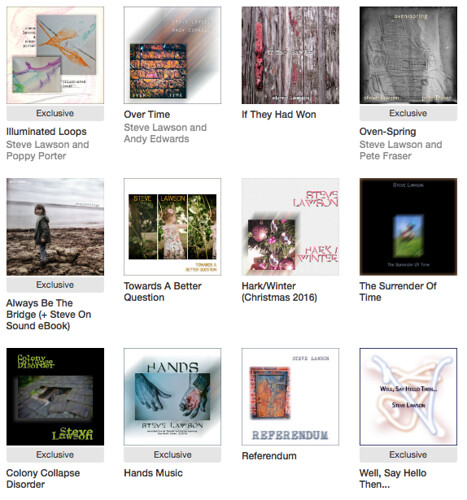 AND IF YOU SIGN UP NOW, BEFORE NEXT WEDNESDAY, YOU’LL BE ABLE TO STAY AT £20 FOR THE DURATION OF THE SUBSCRIPTION. Click here to subscribe now.
AND IF YOU SIGN UP NOW, BEFORE NEXT WEDNESDAY, YOU’LL BE ABLE TO STAY AT £20 FOR THE DURATION OF THE SUBSCRIPTION. Click here to subscribe now.
I’ve said a million times that the subscription is the at the root of my sustainability as an artist. Because gigs and recordings are basically the same thing for me as an improvisor, it’s the subscription that makes all the shows and the recordings of those shows possible. It’s the subscription that pays for plug-ins that mean I do better mixing and mastering, that pay for pedals and software and the TIME to plan things. TIME – that most elusive of commodities. The one that we’re so so bad at quantifying and valuing as artists. Well, y’all make it possible for me to invest time in making better records for you. This is plan A, and right now there is no plan B.
So, go sign up right now, and get a lifetime of music for 30% less than it’ll be if you wait til next week. And if you’ve previously been subscribed and have for whatever reason ended your subscription, now’s a great time to rejoin the party and find out what’s been happening while you’ve been gone!
Thoughts on ECM joining the streaming world
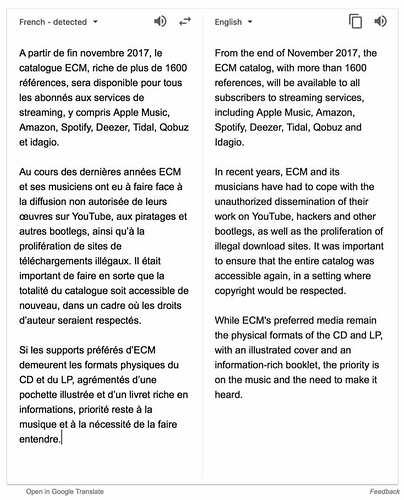 Today’s big (ish) music economy news is that ECM are sticking all of their stuff on the various streaming services v. soon.
Today’s big (ish) music economy news is that ECM are sticking all of their stuff on the various streaming services v. soon.
I’ve never really understood ECM’s economic thinking – I get that they have a historic and aesthetic attachment to CDs and vinyl, but their delving into digital has been seemingly pretty haphazard. For quite a while they had massive parts of their catalogue (perhaps all of it, I never checked) on eMusic – them removing their stuff from eMusic was one of the deciding factors in me cancelling my eMusic account yesterday, after 10 years.
They’ve recently stuck a few things on Bandcamp, but have priced them so high that they’re positioning themselves well outside the mainstream of Bandcamp’s internal economy (as an aside, in the last couple of years, the cost in real terms to a customer in the UK of a download that costs $10 on Bandcamp has jumped from around £7 to around £9, thanks to Brexit trashing our currency, and VATMOSS adding $2 to the price before we even get to that…)
Anyway, so ECM have pulled their stuff from eMusic (where I would pay between about a pound and maybe £3 or 4 per album, depending on the number of tracks) and put it on Spotify, and have put massively overpriced versions on Bandcamp.
Which at face value begs the broader question, why are SO many music people still so utterly binary in their thinking about music distribution? It’s either collect the scraps from streaming and hope that you can magically generate a big enough market to make it meaningful, or charge £10+ per album for CDs AND THE SAME FOR DOWNLOADS ?!?! Continue reading “Thoughts on ECM joining the streaming world”
PS, You Are Brilliant – New Steve Lawson Solo Album Out Today
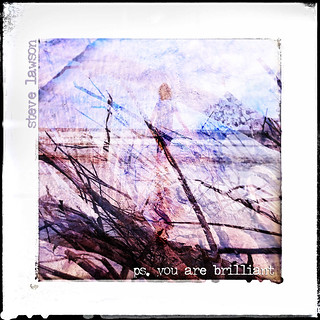 Finally! My new solo album – my NINETEENTH full-length solo release -Â PS, You Are Brilliant, is out today. You can listen to it and download it exclusively on Bandcamp – This is NOT on iTunes, Spotify, Google Play etc. You can only hear it and download it from Bandcamp (or anywhere that has the Bandcamp player embedded, like here!). You can stream the album in full and if you like it and want to buy it, it’s pretty inexpensive 🙂
Finally! My new solo album – my NINETEENTH full-length solo release -Â PS, You Are Brilliant, is out today. You can listen to it and download it exclusively on Bandcamp – This is NOT on iTunes, Spotify, Google Play etc. You can only hear it and download it from Bandcamp (or anywhere that has the Bandcamp player embedded, like here!). You can stream the album in full and if you like it and want to buy it, it’s pretty inexpensive 🙂
Keeping it on Bandcamp is the musical equivalent of only selling your produce in a farmer’s market. It’s a better deal for artists, a better deal for listeners, and you get to choose better-than-CD quality audio if you like at no extra cost. Everybody wins!
If you dig it a lot, and want to investigate further, PS, You Are Brilliant is also available to my Bandcamp Subscribers – I recently passed the 3 year anniversary of the introduction of the subscription, a mechanism for releasing music whereby subscribers pay a flat fee per year and get everything that I release. This year so far, they’ve had 8 albums and an eBook, plus a load of subscriber-exclusive video. Continue reading “PS, You Are Brilliant – New Steve Lawson Solo Album Out Today”
New Music, Nostalgia And The Music Economy – Some Thoughts
[caveat – it’s half term and I have a 7 year old asking me weird and amazing questions every 30 seconds, so this may not be as concise as it could’ve been, but you’re not paying me to write it, so read on 😉 ]
Some questions
- When did you last pay for music by someone you know?
- Do you pay for a streaming service? Does that feel like it’s “enough†because they say that a large percentage of the money they take in goes back to rights holders?
- Have you ever worked out what that’s worth and whether it reflects what you would like to see happen for the musicians you know?
- When did you last buy an old album, something you loved when you were a kid, reissued, remixed, repackaged? How does your spending on reissues compare to your spending on new music?
- How much of your music listening time is spent on music you already know and love vs discovery
- Bonus question: When did you last describe someone online as awesome/genius/amazing that you would have no real intention of investing any time or resources in?
Don’t answer these in the comments – that’s really not the point. The questions are the beginning of a line of questioning that is designed to help us throw some light at how we understand the music economy today.
Here are a few statements I see on a fairly regular basis:
- “no-one pays for music any moreâ€
- “streaming services are destroying the music industryâ€
- “streaming is the future of the music industryâ€
- “Google are making it impossible to be a professional musician, there’s just no money left in musicâ€
- “Piracy has destroyed the music industryâ€
- “There’s too much music these daysâ€
So here are some thoughts to try and connect the series of questions at the top with the statements at the bottom. Continue reading “New Music, Nostalgia And The Music Economy – Some Thoughts”
Bandcamp Subscription Primer – Your Questions Answered!
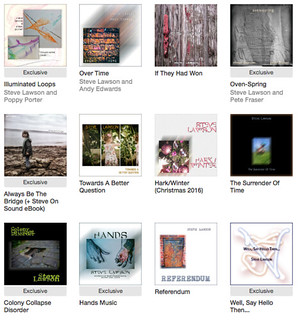 Right, as you no doubt no by now, the Bandcamp artist subscription service has become my primary way of making music available. I’ve had the subscription for 3 years, and in that time have released more music than in the previous 15 years combined. None of it has been ‘demos’ or bootlegs – I just have a music life that results in an awful lot of finished albums. The history of music is littered with great records that were recorded in a single session, live off the floor, and that’s how all my music is made, whether solo or collaborative – and because of the way I’ve built my live rig (after 15 years of tweaking/upgrading/refining), I can get a studio quality multitrack recording of every gig. If I was in a band that played the same set each night, that would result in a single live album, edited from the best bits of the tour, once a year or so. But because I improvise, every gig is potentially an album – and I tend to choose fabulous people to play with, so that ups the likelihood that it’s going to end up being released.
Right, as you no doubt no by now, the Bandcamp artist subscription service has become my primary way of making music available. I’ve had the subscription for 3 years, and in that time have released more music than in the previous 15 years combined. None of it has been ‘demos’ or bootlegs – I just have a music life that results in an awful lot of finished albums. The history of music is littered with great records that were recorded in a single session, live off the floor, and that’s how all my music is made, whether solo or collaborative – and because of the way I’ve built my live rig (after 15 years of tweaking/upgrading/refining), I can get a studio quality multitrack recording of every gig. If I was in a band that played the same set each night, that would result in a single live album, edited from the best bits of the tour, once a year or so. But because I improvise, every gig is potentially an album – and I tend to choose fabulous people to play with, so that ups the likelihood that it’s going to end up being released.
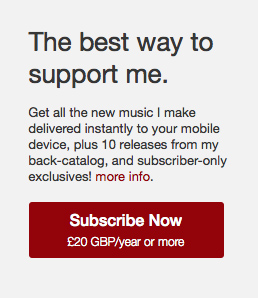 So, the subscription is how you get all of that – it’s just not possible, without several pseudonyms and a full time press team – to do a full, advertised, radio-supported album release for every single one of them. Certainly not to put them out on CD or vinyl. So the subscription means that you don’t have to scrabble around for info about new releases, and I don’t have to waste money advertising a new album every 7 or 8 weeks 🙂
So, the subscription is how you get all of that – it’s just not possible, without several pseudonyms and a full time press team – to do a full, advertised, radio-supported album release for every single one of them. Certainly not to put them out on CD or vinyl. So the subscription means that you don’t have to scrabble around for info about new releases, and I don’t have to waste money advertising a new album every 7 or 8 weeks 🙂
But I know a few of you are still unsure how it works, so here’s a few bullet points that will hopefully answer your questions:
- The subscription is NOT renting the music. Streaming services like Spotify charge you a monthly service to be able to stream their music. If you stop paying, you lose access to the premium aspects of the service, and if you close your account, you lose all the playlists and information that you’ve curated. With my subscription, you own the music – you can download it all in whatever format you like, and it’s yours for ever. If you lose it (stolen phone, crashed hard drive) you can download it all again from Bandcamp without paying any more money, whether or not you’re still a subscriber. YOU OWN IT.
- Bandcamp is, however, also a streaming service. The Bandcamp app gives you access to everything you’ve bought in Bandcamp, and acts as an amazing discovery service too – you can search the whole of Bandcamp via the app, and listen to albums that way, and you get a feed of everything that the people whose fan accounts you follow are buying. So if you follow people with excellent taste, there’s a ready-made recommendation engine there. So when you’re out and about, you don’t have to download all 30 albums (or however many it is now!) to your computer and copy all of that over to your phone – you can just stream it direct from the app, and pick and choose from any of the subscriber music, without the need to pre-plan it.
- But you can also download the same music in multiple formats – so, if you want a lossless version for your computer at home, but the MP3 for your phone (to save on data by not streaming) that’s all good – you can get both versions. Like I said, it’s yours.
- The main purpose of the subscription is to make more music possible. The main focus of the mainstream recording industry is not, in case you were wondering, promoting and selling brand new music. The massive value in their model is in re-selling you access to things you already love. That’s why Spotify works for them – to a large extent, people are paying again to stream music they already own and love. Spotify is a convenience, that has new music thrown in too. But it makes way more sense if your album sold 10 million copies 25 years ago than it does if you’re trying to recoup on a brand new album, without all of that historic investment in your music. Here, my back catalogue is offered to you as part of the subscription so you can catch up. There’s some amazing music in there – I’m deeply proud of all if it, and the journey that it charts through the last couple of decades – but the exciting stuff is what’s still to come. The £20 a year is to make that possible, not to try and squeeze additional money out of music that already exists. I’m less interested in creating ‘passive income’ than I am in making it viable to perform, record and release new music that moves this story forward. So your £20 a year is what makes that possible.
- It’s OK to unsubscribe and resubscribe. This happens a bit. The first year’s offering is massive. 30 albums of anyone is a crazy amount of music. How many artists do you own 30 albums by? I think for me there are about 5 artists. I don’t even know many artists with a catalogue that big. Certainly not niche improvisors like me 🙂 So, you may find yourself after 12 months with enough music. At that point, it’s OK to give it a while before subscribing again. Of course, I’d rather you stayed on board – every subscriber helps to keep the thing viable – but I’m not trying to trick you into staying. I will say, though, that if you unsubscribe, you won’t necessarily get all the music that was released in between when you re-subscribe – quite a few albums are now available to current subscribers for a month, and then removed from the subscription – mostly so the people I’m collaborating with can make some money from that music too! But those are available elsewhere if there’s anything you particularly love, and they’re rarely more than £5. Or you can buy the USB Stick of everything, should that have the missing recordings on it! Or you can stay on board but take a sabbatical from listening to the new stuff. As it’s all yours to own for ever, there’s no time limit on download it. And £20 a year to keep it all flowing into your account is, as the Americans say, chump change 😉
- It’s also OK to unsub and immediately resubscribe in order to change the amount you’re paying. Some people put in an amount much bigger than the minimum £20 when they first sign up. Lots of those people are happy to keep paying that amount. But if you get to the end of the first year, and want to move back to the £20 minimum going forward, it’s easy enough to unsubscribe and resubscribe at the lower rate. Likewise (and even more wonderfully!) it’s possible to do the opposite – to unsub and resubscribe at a higher rate, if the value proposition is one that you think is worth more than the minimum you paid in the first year.
- I don’t currently have a plan B. This is the best possible way I’ve come across for me to keep the music making viable. To be able to collaborate as widely as I do, to do proper, careful, beautiful mixes and mastering on every one of these recordings takes a lot of time, and I just wouldn’t be able to do it if I was sticking half of it up on Soundcloud or YouTube or even releasing it to iTunes etc… The ongoing funding model here means that you’re not having to pay £8 for every album that comes out, and I’m not having to spend thousands marketing this stuff to an audience that need convincing of the value of each individual album.
- I love you all. I really do. The subscribers, past, present and future, are the people who make my music life possible, who create a world where other artists can look at what’s going on here and see a different, new way to make their music, to not get lost in a system where you’re supposed to spend ten grand on a record and twenty grand marketing it and then tour the same 10 songs for a year while filling your YouTube channel with twee covers in the hope that people will hear them and want to buy your album. Nope, there’s a better way – there’s deeper magic to be had, that means we still get to support niche art, art that’s made without an eye on the charts, that’s not beholden to a record label’s promotional schedule, but which results in some amazing music that helps us soundtrack and make sense of this rapidly changing world.
Continue reading “Bandcamp Subscription Primer – Your Questions Answered!”
Two New Albums Released Today!
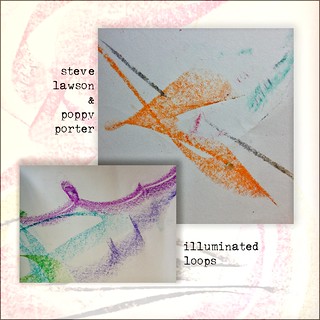 I’ve got two albums coming out today! They’re being released in different ways, and the releases are connected, so read on to find out how to get both!
I’ve got two albums coming out today! They’re being released in different ways, and the releases are connected, so read on to find out how to get both!
First of all, the first Illuminated Loops recording is coming out. Illuminated Loops is my project with visual artist Poppy Porter. Poppy is synaesthetic, which means she ‘sees’ sound. So for this, I improvise, she draws what she sees and I then treat the drawings as a graphic score. It results in a lot of truly beautiful art and some really surprising and lovely music – it’s very much recognisably me, but definitely draws me in new directions and inspires choices that I wouldn’t have made had I just been focused on playing… There’s an awful lot more to be said about the process, which is why the album comes with extensive PDF sleeve notes.
Now, the album will only initially be available to my Bandcamp subscribers. They are the people who pay £20 a year (or more, some of them voluntarily contribute over that) to get everything that I release in the year. They are the reason I’m able to make music the way I do. Last year I put out 7 albums. Some of them were subscriber-exclusives, all of them were released to subscribers a month or so before they became public. And when you first subscribe, you get a massive windfall from my back catalogue – over 30 albums, including every solo album I’ve ever made and a load of subscriber exclusive collaborations too. There are albums in there with Michael Manring, Jem Godfrey, Bryan Corbett and others that are unavailable elsewhere. It’s a crazy bargain, and if you decide to join them today, you’ll get all that music right now, and at some point today, you’ll get the Illuminated Loops album. Continue reading “Two New Albums Released Today!”

